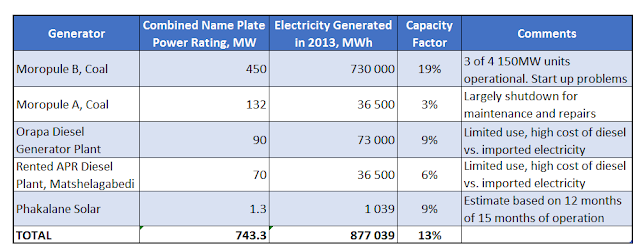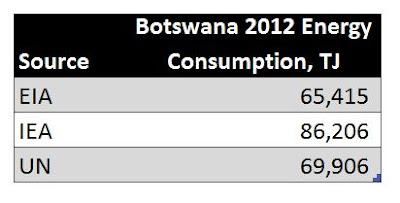Dumelang*. My post this
week is part informative and part instructional. When we discuss energy issues,
a couple of key concepts come up time after time and, to be a contributor to an
energy discussion, we have to know, or familiarize ourselves with, some
technology and terminology. In this post, I want to explain two fundamental
energy concepts. The first is the difference between energy and power, and the
second is capacity factor. I will then show how they can be applied
to electricity production in Botswana.
Let's start with the difference between energy
and power. These terms are often
used interchangeably. This is okay in a general conversation, but in an energy-related
discussion, it can lead to confusion, misunderstanding, errors and bad
decisions. It is essential to be specific about which term you are discussing,
so let’s take a look at distinguishing between the two.
The standard scientific
definition is that Energy is the ability of a system to do
work. It is the quantity which we need to get something to move, heat up, light
up, burn, explode, etc. Energy is not just one thing, however – it comes in
different forms, for example, electrical energy, chemical energy, nuclear
energy, kinetic energy, etc.: much of energy technology deals with converting
one form of energy to another in the most efficient manner. For example,
converting the chemical energy in petrol into the kinetic energy of a moving
car. Some of the more common units of
measurement for energy are kilowatt hours (kWh), megawatt hours (MWh), megajoules
(MJ), and terajoules (TJ).
Power, on the other hand, is the ratio of energy per unit of time
or the rate at which energy is produced from a fuel source or is
converted from one energy type into another. Units of measure for power include
kilowatts (kW), megawatts (MW), joules/second or horsepower (HP).
The confusion between
these two often stems from the similarity of the units like kilowatt hours (which
is an energy unit), and kilowatts (which is a power unit). However, it is
necessary to understand that, even though the units seem similar, there is a
world of difference between them. This difference stems from the simple
mathematical relationship between energy and power:
Energy = Power x time.
One my students in
the Energy and Sustainability program at
Franklin Pierce University noted that energy
and power are analogous to distance and speed. Energy, like distance, is a
quantity, whereas power is a rate like speed. Like the relationship between
energy and power, the relation between distance and speed is written as:
Distance = Speed x time.
Let's consider a simple
backup generator that I have been looking at in the Game Store in Gaborone.
This unit is rated at
5500 Watts or 5.5 kilowatts (kW) under long-term running conditions, so
the power of the unit is 5.5 kW. If I were to run this unit for 1 hour, I would
produce:
5.5 kilowatts
(kW) x 1 hour = 5.5 kilowatt hours (kWh)
of electrical energy
that I could use to run my home. Running it for 24 hours would produce 5.5 kW x
24 h = 132 kWh of electrical energy. The power rating of 5.5 kW is a measure of
the rate at which the backup generator can take the chemical energy in the diesel
fuel and convert it to electrical energy that I can use to keep my home running
during load shedding. The larger the motor on the generator, i.e., the greater
the power, the faster is the rate of energy conversion.
Let’s take a look at another
example. In a car, we convert the chemical energy in petrol into forward
kinetic motion to get us from point A to B. Again, the greater the power of the
engine, the faster will be the rate of energy conversion. The pictures below
illustrate this point.
The Mercedes S500 sedan has
a high-powered 5 liter, 302 HP motor that can more rapidly convert the energy
in the petrol tank into forward kinetic motion than my rental Toyota with its 1.5 liter, 89 HP motor. These two automobile
engines, under specific circumstances, can produce the same amount of energy,
however, the Mercedes can do so in substantially less time. It is likely that the
Mercedes will do so a lot less efficiently than the Toyota—but with a
whole lot more fun.
Let's go back to the Ryobi generator unit so that we can discuss
the second fundamental concept for this post – capacity factor. If I could run
the generator solidly for 24 hours a day for an entire year, I theoretically
could produce:
5.5 kW
x 24 h/day x 365 day/year = 48 180 kW of electrical energy.
However, if I were to
use the generator only for 1 day per month during the year, say during a load
shedding, I would produce:
5.5 kW
x 24 h/day x 12 days = 924 kWh of electrical energy.
Dividing actual produced
energy by the maximum that theoretically could have been generated in a 24/365
scenario produces a ratio called the capacity
factor. In my example above, we would divide 924 by 48 180 to produce a
figure of 0.019, which converts to a percentage of 1.9%: this would be the
capacity factor of my generator for that year. In other words, my generator
only ran at 1.9% of its maximum potential output. Students in the energy field often
confuse capacity factor with conversion efficiency and it is important to
appreciate that they are very different concepts. The capacity factor is a measure
of how much of the theoretical capacity of an energy-generating device was
utilized over a time period, typically one year. On the other hand, conversion efficiency is a measure of the
effectiveness of the conversion of one form of energy, say that in coal, to
another form of energy, for example, electricity. We will be taking a look at
conversion efficiencies in a future post.
With these basic terms—energy,
power and capacity factor—under our belts, let's turn back Botswana energy
issues and particularly electricity generation.
I have examined the 2013
electricity generation figures for Botswana that were published in the Botswana
Power Corporation (BPC) 2013 Annual Report and have combined, in one table,
the generating units, their combined
power, the energy produced from these units, the calculated capacity factors, and the overall
capacity factor for the combined generators in Botswana.
In 2013, there were five
energy-generating operations, including the new (and trouble-prone) generators
at Moropule B, the aging and largely shutdown Moropule A operations, two large-scale
diesel generating operations, one near Orapa and the other near Francistown,
and the 1.3 MW solar plant in Phakalane. The combined nameplate capacity of the
generating units was 743 MW and they generated just over 877 000 MWh of
electrical energy for an overall capacity factor of 13%. (Note that there are
1000 kilowatts in a megawatt, similarly there are 1000 kilowatt hours in a
megawatt hour.)
On examining the
capacity factors, it is interesting to note how far they are from 100%. The
only way a generating device can run at a capacity factor of 100% is by running
24 hours 365 days a year—which is simply not practical or realistic. Equipment
breaks down and has to be repaired or has to be shut down for maintenance.
Moreover, operators of power plants make operating choices, based on the cost
of coal and diesel compared with that of imported electricity, as well as
demand to throttle back their units from their rated or name plate capability.
This reduces the amount of electricity produced which, in turn, reduces
the capacity factor. However, the low capacities of the coal-fired units are of
concern. Typically, coal-fired plants have capacity factors that range from 50
to 80%, depending on location and demand. Low capacity factors for coal-fired
plants result from either low demand or operational issues. In the case or
Moropule B, the problems that have plagued the startup of new generators have
been extensively
reported on in the media.
Generating electricity
using diesel is an expensive proposition and therefore the low capacity factors
of diesel plants are not surprising. These units are seldom used and they function
as back-up generators and are only used in an emergency. In many respects, they
are just like the Ryobi generator I presently have my eye on.
Even though the Botswana-based
generating units are operated separately with different technical and economic
considerations, it is useful to consider their aggregated capacity. As noted
above, the combined nameplate capacity of the generating units is 743 MW. This
combined capacity in a single unit would be one mammoth-sized generator –
we could call it the "Botswana Megarac 743" – which is almost a 140,000
times larger than the Ryobi unit I am eyeing at the Game Store in Gaborone. Looking
at this another way, if Botswana bought 140 000 of these units, it would match
the country’s present generating capacity.
Based on 2013 financial year data, this
Botswana Megarac 743 was operated at a capacity factor 0.13 which means the
combined Botswana facilities only generated 13% of the electricity that was
theoretically possible. Over time, it is hoped that the start-up problems at
Moropule B will be solved and the overall capacity factor for Botswana’s
generating facilities will increase. However, we need to keep in mind that
practical considerations, such as cost and availability of imported electricity,
will also have to be factored in and that Botswana electricity generation is
not an island unto itself. Botswana draws electricity from the Southern African
Power Pool (SAPP) power generation and transmission system which coordinates
electricity supply and demand throughout Southern Africa. The SAPP system has
a combined capacity of about 55 000 MW of
electrical generating capacity.
Hopefully, this has been
an informative and instructional post and you now know the difference between
energy and power and you have an appreciation for capacity factors. As you can
see, capacity utilization of generating facilities is low in Botswana:
hopefully this will improve in the future, but it is crucial to appreciate that
not all of this capacity can be tapped at any one time. Running these
generators depends on complex issues, which include demand, cost and
availability of fuel, maintenance shutdowns and financial considerations.
In the meantime, if you
see me in the parking lot at the Game Store in Gaborone trying to load up that
Ryobi generator into my rental Toyota, stop and give me a hand. Until next
time, remember to turn off those lights when you leave the room.
Tsamayang Sentle**
Mike
Mooiman
mooimanm@franklinpierce.edu
Click here to sign up for notifications about new Energy in Botswana posts
Click here to sign up for notifications about new Energy in Botswana posts
(*Greetings in Setswana)
(**Go well or Goodbye in Setswana)










